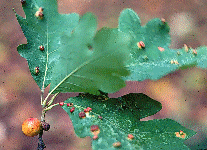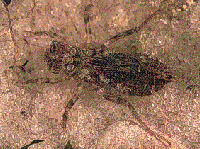
University of Kentucky Department of Entomology







Entfact 806
By Lana Unger,
|
 M. Johnson 1981 | Some insects survive the winter by creating galls on plants. A gall is made up of extra thick layers of plant tissue that grow around an insect. Usually an adult insect lays an egg on the plant's surface. |
The young larva that hatches from the egg, bores into the plant tissue where it becomes surrounded by the gall. Once the gall has formed, the insect stays happily inside the gall, pupates, and emerges in the spring when the weather is nice. There are more than 1500 gall-forming insects in North America. Most gall-forming insects are wasps, flies, beetles and moths.
Body heat
Unlike most bees and wasps that die when the weather turns cold, honey bees are able to use their bodies and wings to create heat inside their hives. A group of bees crowd together in the middle of the hive where they move their bodies and wings to create heat. Another group of bees make a ring around the heat-producing bees to keep the heat from escaping from the hive. When the heat-producing bees get tired, they trade places with the bees in the outer ring. The bees are able to keep the temperature in their hives from dropping below 57øF (14øC). In addition, throughout the year the honey bees use propolis, a sticky substance made up of plant resins and other substances mixed together by the bees, to "caulk" their hives. They spread the propolis all over the inside of the hive. It glues the individual hive cells together and seals any cracks that may have formed in the hive.Underwater
Stoneflies nymphs can be found in fast-flowing shallow streams that do not freeze during the winter months. Some adults emerge from the water during the winter and can be found resting on rocks and plants near the stream bank. | Other aquatic insects, such as dragonflies and damselflies spend the winter underwater as naiads, the immature life stage between egg and adult. |
Ice-covered ponds can be homes for water boatmen and backswimmers. They stay in air pockets under the ice.
Underground
Ants and termites can survive the cold by moving to deeper areas within their underground colonies. We may not be able to see them, but they are alive and well beneath the earth's surface. Ants store food to use during the winter when they are not able to go out to find food.Migration
 Corel PhotoCD | Some insects take an extended vacation when the weather turns cold. One of the most well known migrating insects is the monarch butterfly. |
ACTIVITY
Gall-y Gee Whiz
Things you will need:
- scissors
- knife
- jars
- cheesecloth or fine screen
- rubber bands
Goldenrod plants often have round or egg-shaped galls on their stems. During the winter, the plants will be dead, but the insects within the galls are still alive. You might also be able to find galls on oak trees.
Use scissors to cut the stem or branch below the gall. Collect as many galls as you can find. Ask an adult to help you open some of the galls with a sharp knife. But be careful not to cut the larva inside. If the gall is empty, the gall may be old and the insect may have already emerged. Look for exit holes on the gall. Also birds or other predators may have killed the gall-forming insect. You may be surprised to find a spider or beetle inside the gall taking advantage of the protection from the cold.
Place the rest of the galls in jars. If the plant was still alive when you cut your sample (trees for example), place the cut end of the branch in a cup with a little water so that the branch does not dry out. Place the cup and gall inside the jar. If the plant was already dead (goldenrod), you will not need to provide any additional water. Cover the jars with fine screen or cheesecloth and secure them with rubber bands.
Everyday, check your galls to see if the insects inside have emerged. You may see small wasps, flies, beetles or moths that originally created the gall or you may see a parasitic wasp that killed the original insect and took advantage of the gall's protection.
Keep a journal about your galls:
- Record what types of insects emerge from different types of galls.
- Compare the size of the gall with the size of the insect that emerges.
- How long does it take for the insects to emerge?
Insects All Year and Butterfly cartoons courtesy of C. Ware, copyright 1998
Oak galls image courtesy of M. Johnson, copyright 1981
Monarch butterfly image, Corel PhotoCD, copyright 1996
Last updated: 22 January 1999

 Return to UK Department of Entomology Katerpillars page
Return to UK Department of Entomology Katerpillars page Return to UK Department of Entomology homepage
Return to UK Department of Entomology homepage Return to University of Kentucky homepage
Return to University of Kentucky homepage